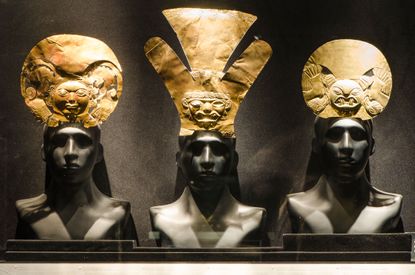Our primal instinct for gold
The yellow metal has been a store of value since the Stone Age, says Dominic Frisby.


As prehistoric man hunted and gathered his way through the Stone Age, he might have come across six native metals (those that occur in nature in a relatively pure state): silver, tin, lead, iron, copper and gold. Gold appeared in river beds. Nuggets, mixed in with sediment, were relatively easy to find and shape. Gold doesn’t naturally combine with other metals, so it is easy to identify. It shone. People adorned themselves with it. The first records of copper use came tens of thousands of years later. Lead, tin and iron’s first use followed, when advances in metallurgy took us into the Bronze Age.
Investing in gold ETCs - how to add gold to your portfolio
The history of gold
Archaeological evidence from Spanish caves used in the late Paleolithic period shows that gold was used by humans as early as 40,000 years ago. This predates agriculture and the development of settled communities. It is the earliest example of human use of any kind of metal, and its purpose was as jewellery. The use of gold for personal adornment was an established practice, even in prehistory. (Even copper’s first use was as jewellery.) Gold, as a symbol of beauty, power and status, also indicates reproductive fitness: “Look at me, I have access to this rare, shiny substance.”
Subscribe to MoneyWeek
Subscribe to MoneyWeek today and get your first six magazine issues absolutely FREE

Sign up to Money Morning
Don't miss the latest investment and personal finances news, market analysis, plus money-saving tips with our free twice-daily newsletter
Don't miss the latest investment and personal finances news, market analysis, plus money-saving tips with our free twice-daily newsletter
Stone Age man had the same basic instincts as we do today: fear, desire, love, hate, greed. Nothing inspires greed like gold. Survival is the most basic compulsion: to find water, food and shelter for yourself and for those close to you. Then there is the survival of your species: the need to reproduce. If you survive, thrive and reproduce, the species as a whole grow stronger.
Thus can an individual’s self-interest be good for the species as a whole? What often goes unmentioned, though, is our instinct for beauty. What we find beautiful is also often good for us in some way. We are instinctively repulsed or alarmed by things that are dangerous (snakes, spiders, a cliff edge) but things that aid our survival we find beautiful: the sound of running water, a fit and healthy potential mate, an open landscape, varied animal and plant life, good visibility and shelter. And we find gold beautiful.
The experience of beauty, whether derived from nature, art, music or even mathematics, correlates with activity in the emotional brain, the medial orbitofrontal cortex. Beauty has long been associated by philosophers with truth and purity – also qualities commonly associated with gold. Our instinct for gold and the emotions it inspires from beauty to desire are basic. There has not been a culture in history that did not appreciate the value of gold. It is a primal instinct. “The desire for gold,” said Wall Street trader Gerald Loeb, “is the most universal and deeply rooted commercial instinct of the human race.”
The artefacts found in those Spanish caves suggest that the people who lived at that time had some basic skills. (Gold, which is relatively soft, is easy to shape even using simple tools.) Gold would have been used as a reward as well as for decoration – as early money, in other words.
Even in prehistory gold was performing the role it has always performed and always will: to store, display and exchange value. Given its unique characteristics – beautiful, eternal, immutable – it is no surprise that gold found special status at the dawn of civilisation. Our prehistoric ancestors cherished gold even before they were able to speak. Nor did that captivation fade. Whether Asian, African, American, Mediterranean, Germanic or Celtic, gold occupies a place in the history and mythology of almost every ancient culture, the most valuable of all metals. As money, it was at the core of all their economies, however primitive.
Gold as a symbol of the sun
Today we know of 90 metals or more. Many you have probably never heard of: yttrium or zirconium, for instance. Until the 13th century we knew of just seven: gold, silver, copper, tin, lead, iron, and mercury. There were also only seven known celestial bodies: the sun, the moon, Mars, Mercury, Jupiter, Venus and Saturn. Each metal came to be associated with a celestial body: silver with the moon; iron, rusty and red, with Mars; Mercury with its namesake; Jupiter with tin. With its glimmering yellow colour, gold was associated with the sun.
To the ancient Greeks, and other cultures besides, the sun was a golden chariot driven by the sun god, Apollo, across the sky each day. The Egyptian sun god Ra was depicted as a yellow blaze of gold. The Incas of South America believed gold to be the sweat or tears of the sun. The Latin word for gold, aurum, derives from Aurora, the goddess of dawn, who rose each morning to announce the sun’s arrival. The root of the word by which the Celts and Greeks referred to gold was the Sanskrit harat, which means colour of the sun.
The symbol for the Sun (a circle with a dot in it ) was once the alchemical symbol for gold. Plato and Aristotle both thought gold was obtained by combining intense sunlight with water.
Kings and queens decorated their bodies with gold to demonstrate their power, to impress, to dazzle, to command and to authenticate their god-like status. Because of gold’s imperishable characteristics many imbued it with divine qualities, and it is forever associated with the eternal, the permanent and the incorruptible. Even today the young student gets a gold star, the athlete a gold medal. It is a symbol of achievement.
Dominic Frisby writes the newsletter The Flying Frisby. His show on gold at the Edinburgh Fringe will take place at Panmure House, in the room in which Adam Smith wrote The Wealth of Nations.
Join us at the MoneyWeek Summit on 29.09.2023 at etc.venues St Paul's, London.
Tickets are on sale at www.moneyweeksummit.com
MoneyWeek subscribers receive a 25% discount.
Dominic Frisby (“mercurially witty” – the Spectator) is the world’s only financial writer and comedian. He is MoneyWeek’s main commentator on gold, commodities, currencies and cryptocurrencies. He is the author of the books Bitcoin: the Future of Money? and Life After The State. He also co-wrote the documentary Four Horsemen, and presents the chat show, Stuff That Interests Me.
His show 2016 Let’s Talk About Tax was a huge hit at the Edinburgh Festival and Penguin Random House have since commissioned him to write a book on the subject – Daylight Robbery – the past, present and future of tax will be published later this year. His 2018 Edinburgh Festival show, Dominic Frisby's Financial Gameshow, won rave reviews. Dominic was educated at St Paul's School, Manchester University and the Webber-Douglas Academy Of Dramatic Art.
You can follow him on Twitter @dominicfrisby
-
-
 Top-quality small companies with big scope for long-term growth
Top-quality small companies with big scope for long-term growthA professional investor tells us where he’d put his money. This week: Dr Gareth Blades, analyst at Amati Global Investors, highlights three favourites.
By Nicole García Mérida Published
-
 Starling Bank hikes fixed savings rate to 5.25%
Starling Bank hikes fixed savings rate to 5.25%Starling Bank has hiked the rate on its fixed savings which has shot up from 3.25% to 5.25% - but how does it compare to the rest of the market?
By Vaishali Varu Published

